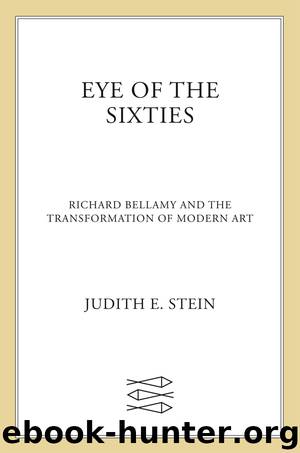Eye of the Sixties by Judith E. Stein

Author:Judith E. Stein
Language: eng
Format: epub
ISBN: 9780374715205
Publisher: Farrar, Straus and Giroux
15
WRONG MAN AT THE RIGHT TIME
It’s a wonder that the Green had a fifth year at all. “I don’t know, Jim. I just don’t know … I don’t think I’m going to open the gallery this fall … and I think I’m going to close it forever in the spring.”1 Rosenquist vividly recalled Dick’s muttered soliloquy, precipitated most likely by Scull’s retreat. Dick was angry and sullen when the Green reopened in September 1964. He had “great animosity” toward Scull for abandoning him, one of his collectors remembered, but “expressed it just in passing.”2 In truth, he’d lost more than his backing. “Dick was best when he had something that rubbed against him,” recalled Samaras.3 With neither flint stone nor support, Dick drank more, which in turn fueled his depression. In one harrowing incident he’d climbed up on a gallery window ledge and had to be talked down.4 He was in a “terrible state,” said Sheindi, who remembered an evening when Miles Forst found him walking down Canal Street toward the Manhattan Bridge.5
Not only was Dick without a backer, but he’d lost his assistants. Jeanie Blake had sat at the front desk or in the back room typing the communiqués he crafted between sips of bourbon. Her sangfroid had been immediately apparent to Dick during her job interview when he lay on the floor and she carried on unperturbed.6 He’d hired her on the spot. Perhaps in reaction to Scull’s pullout, Dick left for Venice without letting her know that the job picked up again in September.7 When he tried to hire her back, she was no longer available. The personable Samuel Magee Green Jr. worked alongside Jeanie doing general office maintenance.8 Dick enjoyed the confusions generated by his surname, and Sam, for whom truth was a malleable commodity, did not correct people when they assumed the gallery was a family business. Like his friend Andy Warhol, Sam was a born social climber, and he gave his name as “Samuel Adams Green” to convey the impression that he was a scion of the Adamses of Massachusetts. He wasn’t. The enterprising young man quit the Green in 1963 to become the first full-time director of Philadelphia’s new Institute of Contemporary Art, a dizzying career move for a twenty-three-year-old.9
So it must have seemed providential when David Whitney answered Dick’s call for help.10 A RISD grad and a former assistant in MoMA’s exhibition department, Whitney was the much-younger life partner of Dick’s client Philip Johnson. With Whitney as his urbane, unflappable first mate, Dick captained the Green for one more year. “What would the art world be like without Dick?” the sculptor Walter De Maria later mused.11 “Dick gave artists a showcase that nobody else would have at that time.” Arne Glimcher, a young dealer from Boston who opened the Pace Gallery at 9 West Fifty-Seventh Street in late fall 1963, regarded the Green as the great “proving ground” of the sixties. It was at the Green where he first saw “things that we had never even considered possible in the vocabulary of art.
Download
This site does not store any files on its server. We only index and link to content provided by other sites. Please contact the content providers to delete copyright contents if any and email us, we'll remove relevant links or contents immediately.
| Africa | Asia |
| Canadian | Europe |
| Holocaust | Latin America |
| Middle East | United States |
Fanny Burney by Claire Harman(26526)
Empire of the Sikhs by Patwant Singh(22974)
Out of India by Michael Foss(16791)
Leonardo da Vinci by Walter Isaacson(13181)
Small Great Things by Jodi Picoult(7019)
The Six Wives Of Henry VIII (WOMEN IN HISTORY) by Fraser Antonia(5394)
The Wind in My Hair by Masih Alinejad(5034)
A Higher Loyalty: Truth, Lies, and Leadership by James Comey(4843)
The Lonely City by Olivia Laing(4750)
The Crown by Robert Lacey(4723)
Millionaire: The Philanderer, Gambler, and Duelist Who Invented Modern Finance by Janet Gleeson(4374)
The Iron Duke by The Iron Duke(4291)
Papillon (English) by Henri Charrière(4195)
Sticky Fingers by Joe Hagan(4101)
Joan of Arc by Mary Gordon(4013)
Alive: The Story of the Andes Survivors by Piers Paul Read(3968)
Stalin by Stephen Kotkin(3875)
Aleister Crowley: The Biography by Tobias Churton(3586)
Ants Among Elephants by Sujatha Gidla(3417)
